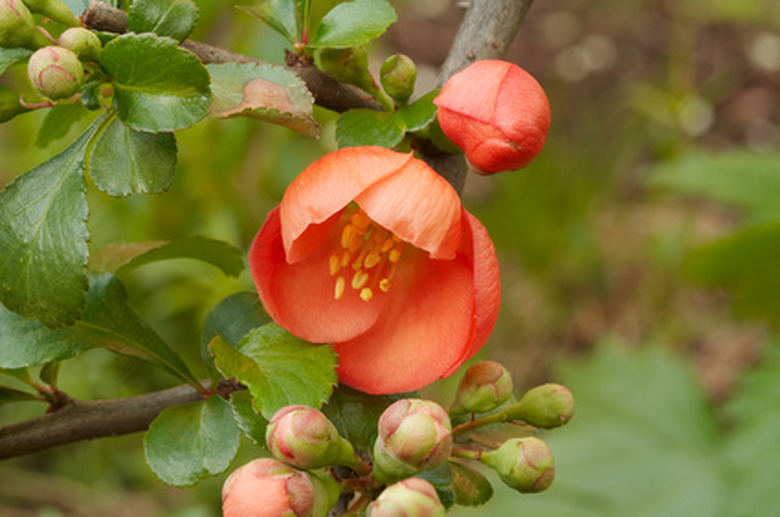Japanese Apple Bush Identification
Japanese apple bush is the common name for a shrub most Americans call Japanese flowering quince (Chaenomeles japonica). Native to the woodlands on Kyushu and Honshu in Japan, Japanese apple bush is a deciduous shrub that blooms anytime from late winter to midspring. It can grow across U.S. Department of Agriculture hardiness zones 5 through 8 in any fertile, well-drained soil that's not too high in alkalinity (pH above 8.0).
Size
Japanese bush apple, or the flowering quince, grows at a moderate pace each year, creating a densely branched plant. Its mature size measures up to 3 feet tall, but its wide-spreading branches reach a diameter between 5 to 6 feet, according to the Learn2Grow plant database. Note that this plant matures to a shorter height than many other flowering quince species or hybrids grown in gardens.
Features
Leaves of Japanese apple bush remain a light green from spring to fall, with little change to yellow-green color in fall's cool weather before dropping off. The branch twigs attain a dark brown color, although the newest growth displays a purplish color, according to a Flora of China description published online by Harvard University. Slender spines or thorns appear sporadically along the length of each branch.
- Japanese apple bush is the common name for a shrub most Americans call Japanese flowering quince (Chaenomeles japonica).
- The branch twigs attain a dark brown color, although the newest growth displays a purplish color, according to a Flora of China description published online by Harvard University.
Flowering Characteristics
In mild, short winter regions, such as in USDA Zones 7 and 8, Japanese apple bush begins blooming in late winter, even earlier if midwinter provides unusually warm spells. Overall, this shrub flowers from March to June depending on climate. Flowers comprise five petals measuring 1 to 1-1/2 inch in diameter with a bright orange-scarlet color.
Fruits
A member of the rose family (and thus related to fruit trees like apples, pears, peaches and cherries), the Japanese apple bush yields small quince- or apple-like fruits in late summer and early autumn. Each "apple" looks yellowy green and measures 1 to 1-1/2 inch in diameter and tastes acidic and bitter. Usually ripe fruits in early autumn are harvested and processed into preserves according to the University of Connecticut. By comparison, the apple-like fruits of Chaenomeles speciosa mature later in fall and become slightly larger, 1-1/2 to 2 inches in size.
- In mild, short winter regions, such as in USDA Zones 7 and 8, Japanese apple bush begins blooming in late winter, even earlier if midwinter provides unusually warm spells.
Considerations
Over the years, horticulturists bred and selected plants of Japanese apple bush as well as hybridized it with Chaenomeles speciosa. Thus, some modern garden cultivars possess intermediate features of both plant parents, making precise species identification challenging. Learn2Grow lists pure genetic lineage of Japanese apple bush in cultivars Super Red, Orange Beauty, Rubra and Sargentii. The University of Connecticut comments that cultivar Texas Scarlet may be a hybrid with Chaenomeles speciosa.
References
- "The Random House Book of Shrubs"; Roger Phillips and Martyn Rix; 1989
- Harvard University: Dichotomous Key and Information on Genus Chaenomeles
